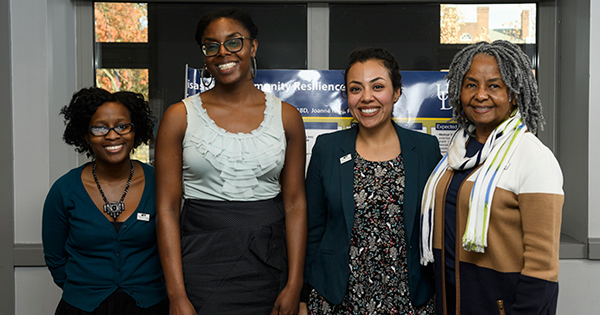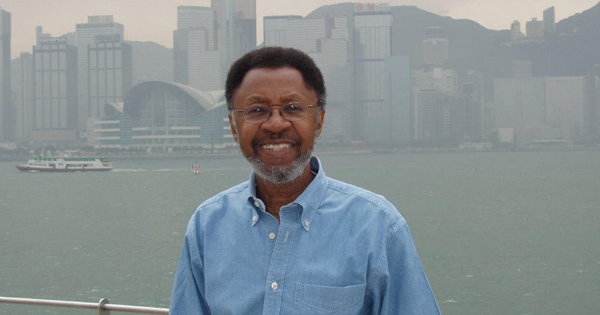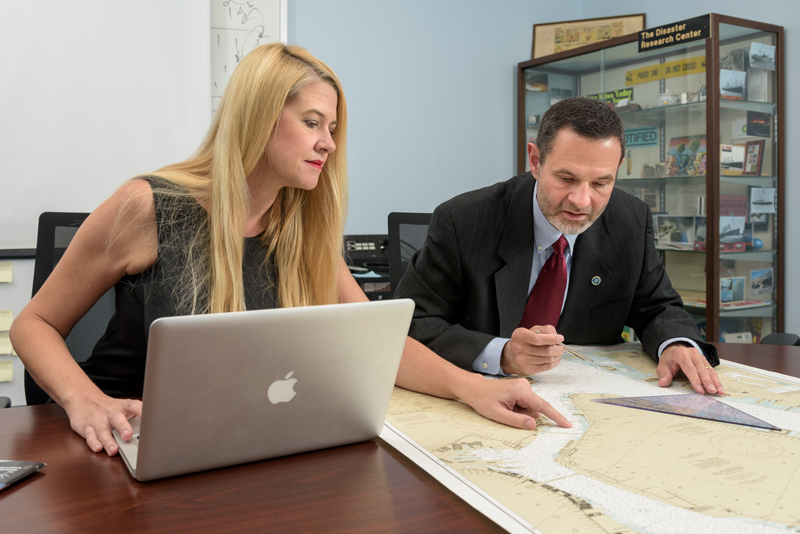


Partners in disaster research
Photo by Kathy F. Atkinson September 28, 2017
Fund that promotes diversity finds new home at UD
When the late William A. Anderson ventured onto the scene of disasters to survey the damage and interview survivors, or when he attended professional conferences during his long and productive career, he often ruefully noted that he was the only African American researcher in sight.
Now, a fund established in his memory and dedicated to his goal of improving diversity in the field of disaster studies has found a home at the University of Delaware.
Anderson, who died in 2013, had longstanding ties to UD’s Disaster Research Center (DRC) and was among the center’s first doctoral students when it was founded in 1963 at Ohio State University. (It moved to UD in the 1980s.)
His widow, Norma Anderson, created the nonprofit Bill Anderson Fund (BAF) in 2014. With what she called “a groundswell of support” from her husband’s many former colleagues, students and protégés, BAF has gone on to provide graduate students across the U.S. with assistance in building careers in disaster research and practice.
“We have a wonderful and very forward-thinking board of directors, and we’ve been very active in holding workshops and mentorship programs,” Norma Anderson said. “But my ultimate goal was always to have the Bill Anderson Fund housed at a university, and to have a director who was an academic.
“I am so thrilled that we’re going to be at the University of Delaware. Bill was in the first cohort of the Disaster Research Center, so in many ways we see him returning to his professional home.”

The University and BAF reached an agreement for UD to become the flagship home of the fund, while other universities around the country are expected to continue their own associations with BAF as satellite institutions. In August, the BAF board of directors unanimously accepted UD’s proposal to house the fund.
A search committee was formed and met this month to begin a national search for a director, who will be a UD faculty member and will also play a leadership role in working with satellite institutions. Plans call for the number of BAF fellows and programs to continue and expand, along with outreach and fundraising efforts.
“Our academic expertise makes us a strategic partner,” said Tricia Wachtendorf, co-director of the DRC, which is the nation’s first center devoted to the social scientific study of disasters. “It also touches our heart because Bill Anderson has been so much a part of us.”
BAF will be housed within the Disaster Research Center in the College of Arts and Sciences and will work to bring together students from across all seven colleges at the University.
Wachtendorf noted that Bill Anderson’s lifelong advocacy for greater diversity among disaster researchers and practitioners is a goal, not just of the fund created in his name but also of the DRC.
“It’s often those in minority communities who are disproportionately exposed to risk in disasters and who suffer disproportionately when disasters occur,” she said. “That’s why it’s even more important to have scholars from those historically underrepresented segments of our communities conducting research and playing an active role in policy decisions.”

Norma Anderson said her husband often spoke about that same issue.
“He was very dedicated to his work, and he was always concerned about the lack of diversity in the field,” she said. “It really resonated with me, and I thought that if I could create this nonprofit to make a positive change in his memory, that would be something we could be proud of.”
Bill Anderson’s other professional passion was his dedication to mentoring, she said. Because he benefited from mentoring early in his career and went on to mentor many others, BAF initiatives focus on mentoring as one of the fund’s two programs.
Bill Anderson Fund Fellows
Fourteen doctoral students, in a variety of disciplines related to disaster studies, are current BAF fellows at several universities nationwide. Another eight students have recently been accepted into the program, Norma Anderson said.
At UD, the current BAF fellows are doctoral students Cynthia Rivas in disaster science and management, April Davison in urban affairs and public policy and Asia Dowtin in geography.
Davison calls BAF “more than a community of scholars and practitioners in the field [but also] a support system.”
As underrepresented minorities in the field, she said, the fellows and their mentors rely on each other for support and celebrate each other’s accomplishments. By participating in the program, Davison said she has been inspired and grateful to learn about Bill Anderson’s career and to follow in his footsteps.
“Norma Anderson knows each fellow personally and is genuinely invested in our path toward success,” she said. “She is a powerhouse [who] has worked tirelessly to see the organization grow and make a difference in the field.”
For Rivas, who recently returned from an exploratory DRC visit to Houston in the aftermath of Hurricane Harvey, the goal of increasing diversity in the study of disasters is a key to finding better solutions in the future.
“What I see the BAF doing is helping give individuals from underrepresented populations opportunities to not only increase representation but bring to the table different ways of approaching, thinking and dealing with disasters,” Rivas said, adding that disaster response is a complex issue and requires a variety of perspectives and approaches.
“When I came into the BAF it not only allowed me to connect to people who are interested in addressing, dealing and solving issues in the disaster science realm but it also allowed me to connect with people that have faced the same circumstances and difficulties as I have and who are coming from underrepresented and vulnerable populations.”
BAF holds three workshops a year, where fellows present their research, share their experiences and network with potential colleagues. The November conference was held at UD, allowing students from other universities—some of which may not have a dedicated specialty in disaster research like the DRC—to connect.
This November, the fellows will be returning to UD for their second annual fall workshop.
Both Wachtendorf and Anderson emphasized the interdisciplinary nature of the field and of BAF and the DRC. From engineering to economics to sociology, they said, graduate students from across UD might become BAF fellows.
“There are so many critical issues, and disasters are going to continue to occur,” Anderson said. “We want to support the leaders of tomorrow in many, many different disciplines.”
About Bill Anderson and the fund
William Averette Anderson earned his doctorate in sociology at Ohio State University in 1966 and went on to a career as a college professor, a National Science Foundation (NSF) officer, a World Bank natural disaster specialist and an official of the National Research Council.
He was known as a pioneering researcher and a leader in fostering student learning and in mentoring the next generation of disaster scholars.
As a professor at Arizona State University, he directed the American Sociological Association’s minority fellowship program. Later, at the NSF, he promoted studies of the effects of disasters on vulnerable populations.
The Bill Anderson Fund aims to expand the number of minority professionals in the field of disaster and hazard research and practice, with the diversity of the field ultimately reflecting that of American society.
Contact Us
Have a UDaily story idea?
Contact us at ocm@udel.edu
Members of the press
Contact us at 302-831-NEWS or visit the Media Relations website

